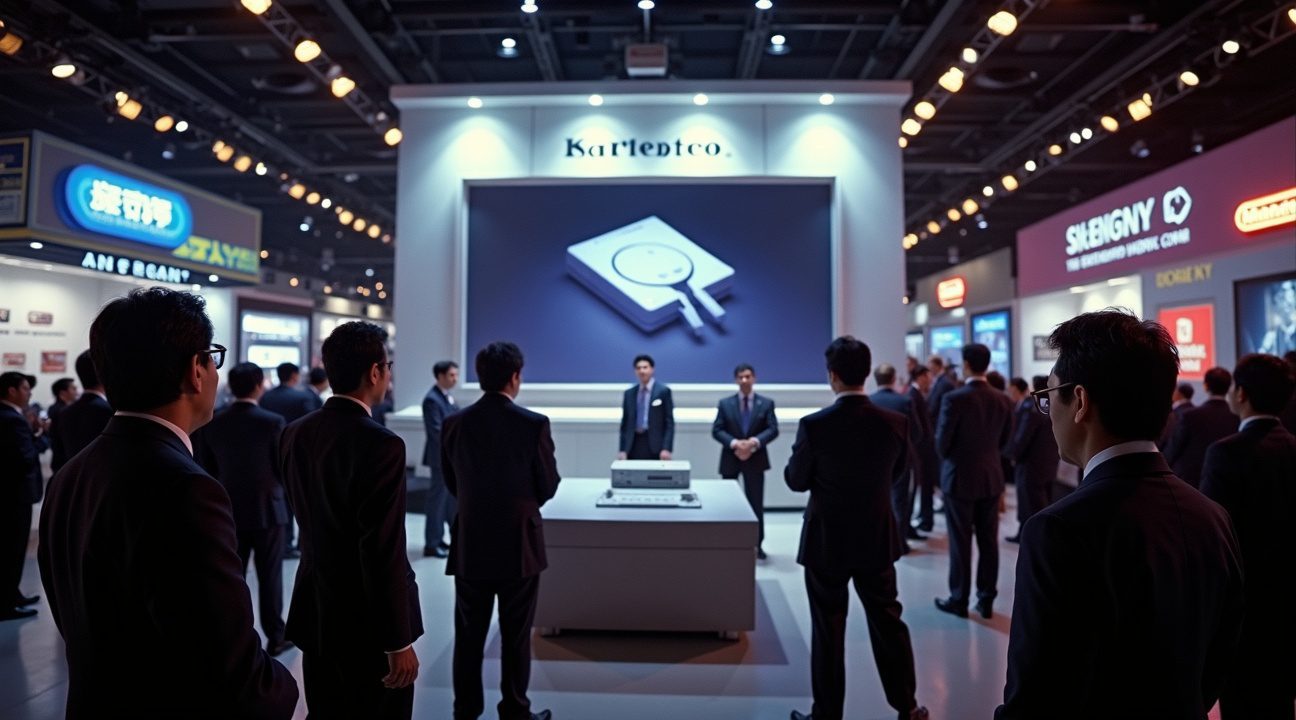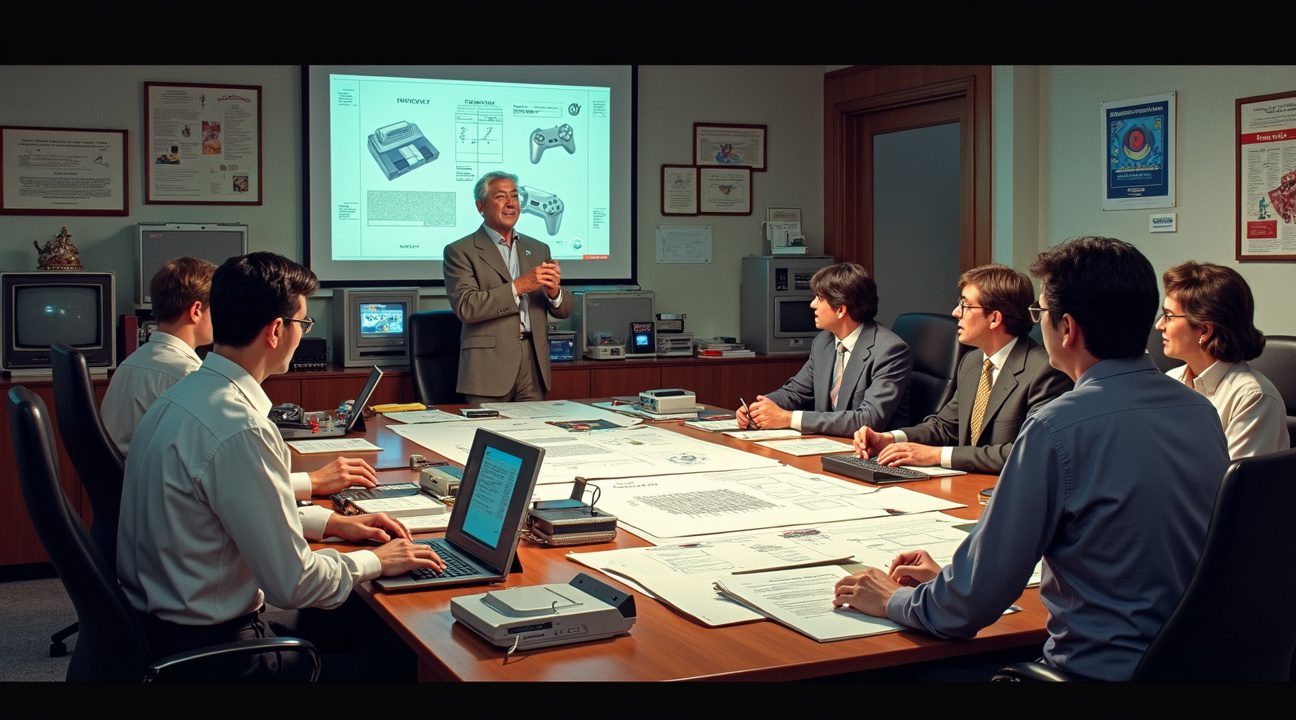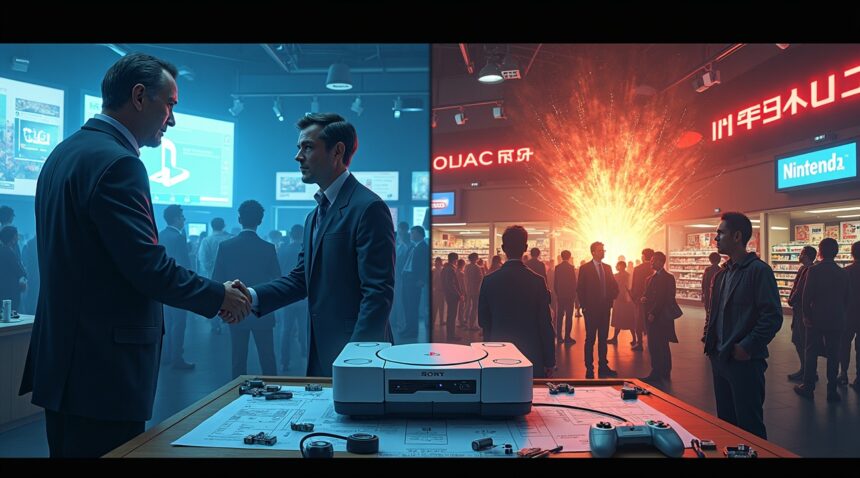In the early 1990s, Nintendo’s sudden betrayal of their Sony partnership at the 1991 Consumer Electronics Show transformed what should have been a collaborative CD-ROM console project into the catalyst for Sony’s independent PlayStation empire.
This corporate backstabbing led Sony to channel their rejection into creating one of gaming’s most successful console brands, ultimately selling over 102 million PlayStation units and fundamentally reshaping the industry’s competitive landscape.
Key Takeaways
- Nintendo and Sony’s partnership began in the late 1980s with Sony developing the SPC700 sound processor for the SNES, leading to plans for a hybrid CD-ROM console called the Nintendo PlayStation
- At the 1991 CES, Nintendo publicly betrayed Sony by announcing their partnership one day, then revealing a competing deal with Philips the next day, effectively ending the collaboration
- Sony transformed this rejection into motivation, establishing Sony Computer Entertainment and developing their own PlayStation console with superior CD-ROM technology and developer-friendly policies
- The original PlayStation became the first home console to surpass 100 million units sold, featuring iconic franchises like Final Fantasy VII, Metal Gear Solid, and Gran Turismo
- Only one functioning prototype of the original Nintendo PlayStation survives today, serving as rare physical evidence of the partnership that could have prevented the console wars and changed gaming history
The Birth of a Failed Partnership
The relationship between Nintendo and Sony started innocently enough in the late 1980s. Sony had already proven their expertise in audio technology by developing the SPC700 sound processor for Nintendo’s Super Nintendo Entertainment System. This successful collaboration naturally evolved into discussions about creating a hybrid gaming console that would combine Nintendo’s cartridge technology with Sony’s advanced CD-ROM capabilities.
Sony engineers worked diligently on what became known as the Nintendo PlayStation prototype. The device featured both cartridge slots and CD-ROM functionality, positioning itself as a revolutionary gaming machine that could bridge traditional and emerging storage technologies. Ken Kutaragi, who would later become known as the “Father of PlayStation,” spearheaded Sony’s technical contributions to this ambitious project.
The partnership agreement gave Sony significant licensing rights for CD-ROM games, which would prove to be a critical factor in the eventual breakdown of negotiations. Nintendo executives grew increasingly uncomfortable with the level of control they had granted Sony over this emerging market segment.
The 1991 CES Betrayal
The Consumer Electronics Show in June 1991 became the stage for one of gaming history’s most dramatic corporate betrayals. Sony proudly unveiled their Nintendo PlayStation prototype on the first day of the show, demonstrating the hybrid console’s capabilities to industry professionals and media representatives.
Nintendo shocked everyone by announcing a completely different partnership with Philips the following day. This announcement effectively terminated their collaboration with Sony without any prior warning or discussion. Nintendo’s executives had secretly negotiated licensing agreements with the Dutch electronics company, leaving Sony executives feeling humiliated and betrayed on the show floor.
Howard Lincoln, Nintendo of America’s chairman at the time, later admitted that the company feared giving Sony too much control over the CD-ROM gaming market. Nintendo’s decision to prioritize short-term licensing control over long-term partnership stability would prove to be one of the most costly strategic mistakes in gaming history.
Sony’s Response and PlayStation Development
Sony’s leadership faced a critical decision following Nintendo’s public rejection. Some executives advocated for abandoning the gaming market entirely and focusing on Sony’s traditional electronics businesses. However, Ken Kutaragi and Norio Ohga, Sony’s president, convinced the company to pursue independent console development.
Sony Computer Entertainment was established in 1993 specifically to develop and market gaming hardware. The company leveraged its existing expertise in CD-ROM technology, audio processing, and consumer electronics manufacturing to create a console that would surpass Nintendo’s capabilities in multiple areas.
The development team focused on creating developer-friendly hardware and licensing policies. Sony offered more favorable royalty rates compared to Nintendo’s restrictive agreements, attracting numerous third-party developers who had grown frustrated with Nintendo’s rigid control over game production and distribution.
Sony’s engineers also prioritized 3D graphics capabilities, recognizing that polygonal rendering would become increasingly important for next-generation games. This technical foresight gave the PlayStation a significant advantage over competitors who remained focused on 2D sprite-based graphics.
The PlayStation’s Market Impact
Sony launched the original PlayStation in Japan in December 1994, followed by North American and European releases in 1995. The console’s $299 price point undercut Sega’s competing Saturn system by $100, immediately establishing PlayStation as an attractive option for cost-conscious consumers.
The PlayStation’s game library became its greatest strength. Sony secured exclusive partnerships with major developers including Square (Final Fantasy series), Konami (Metal Gear series), and Polyphony Digital (Gran Turismo series). These relationships produced iconic games that defined the console’s identity and attracted millions of dedicated fans.
Ridge Racer showcased the PlayStation’s 3D graphics capabilities at launch, while later titles like Final Fantasy VII demonstrated the storytelling potential of CD-ROM storage. The console’s ability to play audio CDs also added value for consumers who wanted multimedia functionality in their gaming systems.
Sony’s marketing campaigns targeted older demographics compared to Nintendo’s family-friendly approach. This strategy helped expand the gaming market beyond traditional younger audiences, establishing gaming as a mainstream entertainment medium for adults.
The Surviving Prototype
Only one functioning Nintendo PlayStation prototype exists today, making it one of gaming’s most valuable artifacts. Terry Diebold purchased the prototype at an estate sale in 2009 for approximately $75, unaware of its historical significance at the time. His son discovered the device’s importance through online research, leading to extensive authentication efforts.
Console Classics Gaming in New York authenticated the prototype’s legitimacy through detailed technical analysis. The device features both Super Nintendo cartridge slots and a CD-ROM drive, along with unique branding that combines both companies’ logos. The prototype can play standard Super Nintendo cartridges but lacks compatible CD-ROM software since the partnership ended before game development was completed.
Heritage Auctions estimated the prototype’s value at over $1 million due to its rarity and historical importance. The device represents a pivotal moment in gaming history when two industry giants could have reshaped the competitive landscape through collaboration rather than confrontation.
Long-term Industry Consequences
Nintendo’s betrayal of Sony created lasting changes in the gaming industry’s competitive dynamics. The PlayStation brand evolved into Sony’s most successful consumer electronics product line, generating billions in revenue across multiple console generations. Sony’s entry into gaming also intensified competition, leading to rapid technological advancement and more consumer-friendly business practices across the industry.
The success of the original PlayStation demonstrated that established electronics companies could successfully challenge traditional gaming manufacturers. This precedent encouraged other technology companies like Microsoft to enter the gaming market with the original Xbox in 2001.
Nintendo’s decision to prioritize cartridge technology over CD-ROM storage proved increasingly problematic as games required larger storage capacities. The company didn’t fully embrace optical disc technology until the GameCube in 2001, giving Sony and other competitors significant advantages in terms of game development flexibility and manufacturing costs.
The partnership’s collapse also highlighted the importance of carefully structured licensing agreements in technology collaborations. Future partnerships between gaming companies became more detailed in defining control over intellectual property, revenue sharing, and strategic decision-making authority.
Sony’s PlayStation legacy continues to influence modern gaming through innovations in online services, virtual reality, and mobile gaming integration. The company’s willingness to invest heavily in exclusive game development and cutting-edge hardware technology stems directly from lessons learned during the original PlayStation’s development and marketing campaigns.
Sony’s PlayStation Became Gaming’s Biggest Success Story After Nintendo Betrayal
Sony transformed rejection into unprecedented triumph when the Nintendo PlayStation project collapsed. The PlayStation launched on December 3, 1994, in Japan with explosive results. I watched as gaming history unfolded when Sony sold 100,000 units on that first day alone, proving their console could compete with established players.
Within six months, Sony achieved something remarkable—2 million units sold in Japan. The North American release followed on September 9, 1995, bringing the PlayStation to Western audiences hungry for next-generation gaming. Sony’s aggressive pricing strategy worked perfectly, with the console retailing for ¥39,800 in Japan and approximately $299 USD in North America, effectively undercutting key rivals like the Sega Saturn.
Record-Breaking Sales Performance
The PlayStation’s commercial success shattered industry records. Sony’s console became the first home video game system to surpass 100 million units sold, ultimately reaching over 102 million units worldwide. This achievement dwarfed competitors across the board:
- Nintendo 64 managed 32.93 million units
- Super Nintendo Entertainment System reached 49.1 million units
- Sega Saturn struggled with only 9.5 million units
Sony’s software library grew to staggering proportions, featuring over 4,000 titles with more than 962 million software units sold. This extensive game catalog gave players countless entertainment options and developers multiple revenue streams.
Major game franchises either debuted or found new life on Sony’s platform. Gran Turismo redefined racing games with realistic physics and stunning graphics. Final Fantasy VII brought Japanese RPGs into mainstream Western consciousness. Metal Gear Solid elevated stealth-action gaming to cinematic levels. Resident Evil terrified players with survival horror gameplay. Crash Bandicoot became Sony’s unofficial mascot through platforming excellence. Tekken 3 dominated the fighting game scene with fluid combat mechanics.
Sony’s strategic decisions fundamentally changed how consoles operated. The failed Nintendo PlayStation partnership taught Sony valuable lessons about controlling their destiny. CD-ROM technology replaced expensive cartridges, dramatically reducing manufacturing costs while increasing storage capacity. This shift allowed for full-motion video, CD-quality audio, and larger game worlds that cartridge-based systems couldn’t match.
Third-party developer relationships became Sony’s secret weapon. Unlike Nintendo’s restrictive licensing practices, Sony welcomed developers with open arms and reasonable terms. This approach attracted talent previously locked into exclusive Nintendo partnerships. Independent studios found freedom to experiment and innovate without excessive corporate oversight.
Sony’s marketing campaigns targeted older demographics than traditional console manufacturers. They positioned the PlayStation as entertainment for teens and adults rather than just children’s toys. This strategy expanded the gaming market significantly and established video games as legitimate mainstream entertainment.
The PlayStation’s technical specifications impressed developers and consumers alike. Its 32-bit architecture, dedicated graphics processing unit, and substantial RAM enabled 3D gaming experiences previously impossible on home consoles. These capabilities attracted arcade developers who could finally port their cutting-edge games without significant compromises.
Sony’s success stemmed from learning painful lessons during the cancelled Nintendo PlayStation project. They understood that controlling hardware, software licensing, and developer relationships was crucial for long-term success. Nintendo’s betrayal became Sony’s motivation to dominate an industry they initially approached as partners.
The PlayStation’s legacy extends far beyond sales figures. Sony proved that newcomers could challenge established gaming giants through innovation, strategic pricing, and developer-friendly policies. Their success fundamentally altered the competitive landscape and established Sony as gaming’s new powerhouse.

The 1991 Betrayal That Shocked Corporate Japan
At the 1991 Consumer Electronics Show (CES), Sony proudly unveiled its groundbreaking collaboration with Nintendo on a revolutionary gaming device called the Play Station. This hybrid console promised to bridge the gap between traditional cartridge-based gaming and the emerging CD-ROM technology, representing what many believed would be the future of home entertainment.
The Nintendo and Sony partnership appeared rock-solid to industry observers. The Play Station would deliver SNES cartridge compatibility while introducing powerful CD-based gaming capabilities that could store vastly more data than traditional cartridges. Sony’s expertise in audio technology combined with Nintendo’s gaming prowess seemed like a match made in heaven.
However, the corporate landscape shifted dramatically within 24 hours. Nintendo stunned the entire industry by announcing a completely different partnership with Dutch electronics giant Philips the very next day. The Kyoto-based gaming company cited growing concerns about Sony’s contract terms, particularly clauses that would grant Sony excessive control over licensing agreements and revenue streams from CD-based content.
Corporate Trust Shattered in Public View
This unexpected announcement sent shockwaves through corporate Japan, where business relationships are built on decades of careful trust-building and mutual respect. Sony executives felt blindsided by what they perceived as a calculated betrayal executed on the world’s largest consumer electronics stage. The timing couldn’t have been more humiliating – announcing the Sony partnership one day only to reveal its replacement the next demonstrated a level of corporate ruthlessness that violated traditional Japanese business ethics.
The fallout was swift and decisive. Sony severed all ties with Nintendo in May 1992, marking the end of what could have been one of gaming’s most powerful alliances. By this point, approximately 200 prototype Play Station units had already been manufactured in Sony’s facilities. These rare prototype consoles could seamlessly play both SNES cartridges and the new CD-based games that were already in various stages of development.
The betrayal cut particularly deep because Sony had invested significant resources into the project. Engineers had spent months perfecting the hybrid technology, software developers were creating compatible games, and manufacturing lines were being prepared for full production. Nintendo’s sudden pivot to Philips meant all this investment would need to be completely reimagined or abandoned entirely.
This corporate drama had implications far beyond the immediate business relationship. The public nature of the betrayal damaged Nintendo’s reputation in Japan, where such behavior contradicted established norms of corporate conduct. Meanwhile, Sony faced a critical decision: retreat from the gaming market entirely or forge ahead independently.
The answer came in the form of Sony’s determination to prove they could succeed without Nintendo’s partnership. What started as a collaborative effort to enhance Nintendo’s console ecosystem transformed into Sony’s independent console empire. The 200 prototype units became valuable artifacts of gaming history, representing the moment when Sony decided to become Nintendo’s most formidable competitor rather than its collaborative partner.
This betrayal fundamentally altered the trajectory of the gaming industry. Instead of one dominant console combining both companies’ strengths, the market would soon witness an intense rivalry that pushed both companies to innovate at unprecedented levels. The partnership that never was became the catalyst for one of gaming’s most significant competitive periods.
https://www.youtube.com/watch?v=k7n5kRRHDnw

How Nintendo and Sony First Joined Forces in the Late 1980s
During the late 1980s, Nintendo stood as the unquestioned king of home console gaming. The company’s NES and Famicom systems dominated households worldwide, while developers prepared for the revolutionary Super Nintendo Entertainment System (SNES) launch. At this critical juncture, Nintendo and Sony formed an unexpected partnership that would reshape gaming history.
Sony’s involvement began through Ken Kutaragi, a talented engineer who recognized the potential for advanced audio technology in gaming consoles. Kutaragi spearheaded Sony’s development of the SPC700 sound processor, a groundbreaking component that would dramatically enhance the SNES’s audio capabilities. This processor delivered rich, layered soundtracks and crystal-clear sound effects that set the SNES apart from its competitors.
The initial collaboration proved so successful that both companies decided to expand their partnership. Nintendo recognized Sony’s technical expertise, while Sony saw an opportunity to enter the lucrative gaming market alongside an established leader. This mutual benefit created the foundation for their next ambitious project.
The Birth of the SNES-CD Project
Building on their audio processor success, Nintendo contracted Sony in 1988 to develop something far more ambitious: a CD-ROM add-on for the SNES. This device, initially called the Play Station or SNES-CD, represented a bold leap forward in gaming technology. The system would support both traditional game cartridges and the new CD-ROM format, combining the best of both storage methods.
CD-ROM technology offered several compelling advantages over cartridges:
- Games could store vastly more data
- Larger worlds and longer storylines became possible
- Enhanced multimedia elements like full-motion video and CD-quality audio
Developers would no longer face the strict size limitations that cartridges imposed, opening doors for more complex and immersive gaming experiences.
The partnership seemed perfect on paper. Nintendo brought decades of gaming expertise and an established market presence, while Sony contributed cutting-edge hardware engineering and manufacturing capabilities. Both companies invested significant resources into this lost console project, believing it would define the next generation of gaming.
Sony’s engineers worked closely with Nintendo’s development teams to ensure seamless integration between the CD-ROM system and existing SNES hardware. The resulting hybrid console would maintain backward compatibility with all existing SNES games while introducing revolutionary new possibilities through CD-ROM technology.
However, the partnership contained the seeds of future conflict. Contract negotiations revealed fundamental disagreements about licensing rights, revenue sharing, and control over the new CD-ROM format. Sony’s details about the project later revealed how these business tensions would ultimately derail the collaboration.
The technical and creative groundwork established during this period proved invaluable for both companies:
- Nintendo gained insights into CD-ROM technology and multimedia capabilities that would influence future console designs
- Sony developed crucial gaming hardware expertise and began understanding the unique requirements of interactive entertainment
This early partnership established the philosophical framework that would guide both companies’ future console development. Nintendo’s focus on gameplay innovation combined with Sony’s emphasis on technical advancement created a template for successful gaming systems. Even after their partnership dissolved, both companies continued pursuing these complementary approaches.
The collaboration between Nintendo and Sony in the late 1980s represented more than just a business arrangement. It brought together two industry giants with different strengths and perspectives, creating innovations that pushed gaming technology forward. While their partnership would eventually end in disappointment and legal disputes, the technical foundations they built together would influence gaming for decades to come.

Sony’s Transformation from Partner to Gaming Powerhouse
The failed Nintendo PlayStation project didn’t mark the end of Sony’s gaming ambitions—it sparked them. After Nintendo’s betrayal at the 1991 Consumer Electronics Show, Sony explored potential partnerships with other companies, including Sega. However, Sega also rejected Sony’s advances, leaving the electronics giant with a clear message: the established gaming companies weren’t interested in sharing their market dominance.
Rather than retreat, Sony executives recognized an opportunity to leverage their existing research and technology from the cancelled Play Station project. The company had already invested significant resources in developing CD-ROM gaming technology and understood the potential of this medium. Sony made a bold decision that would reshape the entire gaming industry—they’d create their own gaming console from scratch.
Building the Foundation for PlayStation
Sony established Sony Computer Entertainment as a dedicated gaming division and placed Ken Kutaragi at the helm of console development. Kutaragi, who had already proven his expertise during the Nintendo partnership, brought deep technical knowledge and a vision for what gaming could become with proper hardware support.
The company’s first major strategic move came in 1993 when they acquired UK-based Psygnosis for $48 million. This acquisition proved crucial because it instantly provided Sony with an established game development studio capable of creating compelling launch titles. Psygnosis brought proven expertise in creating visually impressive games and understood how to push hardware to its limits.
Sony also partnered with SN Systems to refine their hardware approach. The team focused on creating a console specifically designed for affordable CD-ROM-based games while delivering advanced 3D polygon graphics that surpassed anything available on cartridge-based systems. This technical foundation would become the PlayStation’s defining advantage.
Revolutionary Developer Relations Strategy
Sony’s approach to third-party developers represented a complete departure from Nintendo’s business model. Where Nintendo maintained strict licensing policies and limited production runs, Sony opened their platform with more favorable terms. They made development tools more accessible and affordable, recognizing that a diverse library of games would drive console sales more effectively than restrictive policies.
The strategic focus extended beyond just technical capabilities. Sony deliberately targeted an older demographic of teens and adults rather than focusing primarily on children. This decision opened up new market segments and allowed for more sophisticated game content that appealed to players who had grown up with earlier gaming systems.
Third-party developers, who had felt constrained by Nintendo’s rigid policies regarding content approval and manufacturing quotas, found Sony’s approach refreshing. The company offered:
- Better revenue splits
- More creative freedom
- Faster approval processes
These developer-friendly policies attracted talent that had previously worked exclusively with Nintendo or had been shut out of console gaming entirely.
Sony’s combination of superior CD-ROM technology, aggressive pricing, and developer-friendly policies created a perfect storm that disrupted the gaming industry. The partnership that never was with Nintendo had inadvertently created Sony’s greatest motivation to succeed independently.
By the time the original PlayStation launched, Sony had transformed from a consumer electronics company with gaming aspirations into a formidable competitor that would challenge and ultimately surpass both Nintendo and Sega. The lessons learned from the cancelled Nintendo project, combined with strategic acquisitions and a revolutionary approach to developer relations, positioned Sony to reshape the gaming landscape throughout the mid-1990s and beyond.
The Rare Nintendo PlayStation Prototype That Started Console Wars
I find it fascinating that the rarest gaming artifact in existence isn’t a legendary cartridge or limited edition console – it’s a machine that represents one of the biggest “what if” moments in gaming history. The prototype Nintendo PlayStation stands as physical evidence of a partnership that could have changed everything.
A Hybrid Console That Never Reached Players
The prototype itself was an engineering marvel for its time. Engineers designed it to support both Super Famicom cartridges and audio CDs, creating a bridge between Nintendo’s established cartridge technology and Sony’s advancing disc-based systems. This hybrid approach would have given players access to existing SNES games while opening doors to larger, more complex titles that CDs could accommodate.
However, the planned CD gaming functionality never reached completion. The prototype could play audio CDs but lacked the finalized gaming capabilities that would have made it revolutionary. This incomplete state makes the surviving unit even more intriguing – it represents a glimpse into what might have been the first true multimedia gaming console.
The Last Surviving Piece of Gaming History
Only one known functioning prototype exists today, and it remains in private hands. Its rediscovery in recent years sent shockwaves through the gaming community and rekindled massive interest in this pivotal moment. Collectors and historians recognize its value not just as a rare item, but as tangible proof of the partnership that never was.
The machine’s existence proves that Nintendo and Sony came closer to collaboration than many realized. Engineers from both companies worked together, creating functional hardware that demonstrated real potential. Yet this cooperation would soon dissolve into one of gaming’s most consequential corporate breakups.
The failed deal between Nintendo and Sony proved instrumental in fracturing Nintendo’s market dominance. When Sony decided to proceed alone after Nintendo’s withdrawal, they created direct competition that forever changed the industry landscape. This prototype represents the exact moment when gaming shifted from Nintendo’s near-monopoly to the competitive console wars that defined the 1990s and continue today.
Without this failed partnership, Sony might never have entered gaming, PlayStation wouldn’t exist, and Nintendo might have maintained its stranglehold on the console market. The prototype serves as a reminder that gaming history pivoted on this single collaboration that never came to fruition.
Sources:
Wikipedia, “PlayStation (console)”
PlayStation Museum, “PlayStation History”
XDA Developers, “Inside the rare Nintendo PlayStation prototype: History, restoration, and legacy”
PlayStation Fandom, “Nintendo PlayStation”
GameFAQs, “The Top 10 Facts You May Not Know About The PlayStation”
TechFaster, “The History Of The Playstation In An Infographic”
Museum of Play, “How Software Development Helped Make Sony’s PlayStation the King of 1990s Consoles”

